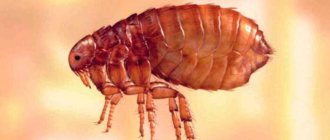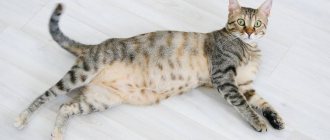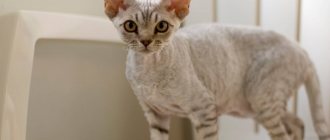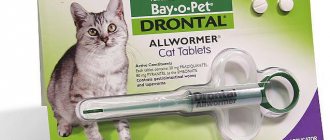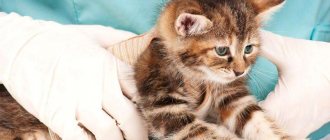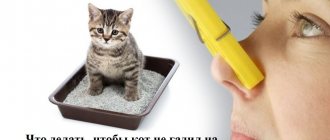Not a single cat is immune from the appearance of fleas, even those that have never been outside the apartment. Fleas not only cause pain to pets, but can also infect them with serious diseases. Fortunately, fleas on a cat are not forever; there are effective ways to get rid of parasites using industrial preparations, as well as to remove fleas with home remedies. Home remedies do not work very quickly, but they are not toxic and are suitable for almost all animals - from pregnant cats to small kittens.
What does a flea look like?
If you look at a flea under a microscope, this blood-sucking insect looks like a scary monster. The flat body, 1.5 to 4 mm long (1), is attached to paws covered with spikes for easy movement through the fur. The hind legs are especially powerful - after all, this helps the flea to jump as much as half a meter in length (this is like a person jumping 200 m). On the small head of the flea there is an oral cavity that is capable of biting through the rather tough fur of the animal. A real monster, you say. And you'll be right.
Although, due to their small size, fleas seem to be inconspicuous and harmless insects, in fact this small midge is about 3 millimeters in length, but is capable of bringing truly hellish torment to its owner. So if you notice small brown insects with a flat body in your cat’s fur, gathering in groups near the ears (the skin is softer there), then these are undoubtedly fleas.
Detection of insect feces
Reliable signs of the presence of fleas (in addition to the detection of live insects) is the presence of their feces. They look like brown-red or black dots located on the skin at the base of the hairs. When crushed between the fingers, the feces crumble and leave a reddish mark.
With a small number of insects, black spots are most often localized in a cat in the abdomen, spine and at the base of the tail.
Where do fleas come from in cats?
As it turns out, it is simply a myth that an indoor cat that does not leave the apartment and does not walk with outdoor cats cannot become infected with fleas. These parasites, in search of a victim, are quite capable of moving long distances on their own, even feeding on raids, without using an animal. Therefore, it can be difficult for owners to detect whether a cat has fleas.
The main causes of fleas in cats:
- from another infected animal;
- from you, you could bring a flea from the street on your own clothes;
- from a neighbor’s apartment or basement if you live in an old house or the neighbors do not process their animals;
- from your dog (yes, fleas are also transmitted from dogs to cats) who picked up a flea on the street.
– Fleas in animals are a very relevant topic, since most dermatological patients suffer precisely because of this problem. In veterinary medicine there is such a disease as atopic flea dermatitis - an allergy to flea saliva (2). It occurs in many patients and manifests itself as dermatitis and itching. This is also a problem because many owners believe that there cannot be fleas in their apartment or on their animal. Unfortunately, we do not live in sterile conditions and in residential buildings, especially if they are not new, fleas can live in basements, be in baseboards, or simply get from the entrance to the apartment. Both a walking animal and a completely domestic animal can become infected,” says veterinarian Marina Mikheenko.
Symptoms of fleas in cats
You can tell if your cat has fleas by the following symptoms:
- the cat began to itch frequently and for a long time;
- small wounds covered with a crust appeared on the cat’s skin;
- the cat began to sleep restlessly: what is called to scratch itself, jumps up in its sleep;
- the cat's appetite has decreased;
- When examining the fur, you can notice black dots - flea excrement, and you can also notice the insects themselves, which quickly move inside the hairs.
When fleas get on a cat's fur, they bite through its skin to feed on blood. This causes pain to the animal, flea bites itch, so the cat can not only scratch them vigorously, but also introduce an infection, turning the wounds into purulent abscesses. But the worst thing is that fleas are carriers of dangerous infections that can be fatal to cats. And the sooner you find fleas on your cat, the easier it will be to remove these dangerous parasites. By the way, although fleas do not live on people, they can bite them, so the owners are also at risk.
Symptoms of infection
Veterinarians identify certain signs that indicate the presence of bloodsuckers. Symptoms directly depend on the extent of spread. There are 3 main stages:
- Initial, which can be detected by a very attentive owner during a thorough examination of the pet’s fur. The only obvious sign will be more frequent scratching than usual.
- The second stage is characterized by increased nervousness, sleep disturbances, and lack of appetite. The cat begins to gnaw something out of the skin, biting itself at the same time. Bloodsuckers are clearly visible on the hairline, especially at its base.
- The third stage is manifested by a clear deterioration in health, weight loss, and refusal to eat. Severe ulcers on the skin are noticeable, and allergic dermatitis begins. Hair falls out in clumps, the coat becomes very thin to the touch and becomes dull.
Any stage of the disease serves as a signal to begin active action. Timely treatment will help eliminate symptoms, help your pet, and prevent the spread of insects throughout the house or apartment.
How to remove fleas from a cat
To combat fleas, there are insecticides - preparations prepared on the basis of substances that destroy parasites. They are produced industrially and are available in various forms: in the form of drops on the withers, sprays for fur, collars, shampoos. Their common feature is that they are quite toxic not only to fleas, but also to the cats themselves, so such drugs are not recommended for use in pregnant or lactating cats, kittens up to three months old, elderly and sick animals, as well as cats prone to allergic reactions.
How to remove fleas from cats at home
Nowadays there are quite a lot of medications on sale to cope with fleas in cats. Some pet owners prefer folk remedies such as rosemary infusion and wormwood soap. The effectiveness of such products has not been proven. But on sale there are proven medicinal sprays, shampoos, tablets and even flea collars that will help your animal live a comfortable and healthy life. Let’s take a closer look at which product you should choose.
Flea collars for cats
This is one of the most popular remedies for fleas among cat owners, probably because deep inner instincts and a craving for amulets are triggered, that if you hang a collar with a bell on your cat, the flea will immediately understand that this animal is under the protection of higher powers and should not bite it in any way case is not allowed.
Just a joke, of course. No, there is still some benefit from flea collars treated with special agents. This benefit is preventive, since the smell of the medicine actually repels fleas. But this product also has undeniable disadvantages:
- some of them are very toxic, so it is imperative to use only collars with special markings for cats;
- the zone of influence of the collar is located next to the cat’s head and ears, but who will protect the kitten’s butt, because it is on the cat’s soft spot that fleas can have fun and overeat with impunity;
- The collar lasts on average about a month, so it is quite an expensive pleasure, and if you do not change it on time, it is simply a useless decoration for your pet.
“ Many people use anti-flea collars, but if they work and fleas are still observed (and also cause a local allergic reaction), it is recommended to use drops on the withers ,” advises veterinarian Marina Mikheenko.
Flea shampoos for cats
Flea shampoos are a fairly popular remedy for fighting parasites. It is important to consider two things here. So that the shampoo is from a trusted manufacturer and specifically for cats. And so that the flea infestation does not reach a strong, critical stage (for those who still do not understand what this stage is - this is when you part the fur, and there a seedling of small brown insects does not even try to hide from your gaze).
In general, using shampoo is quite safe and effective; just remember to thoroughly rinse the animal’s fur several times with running water so that there is no shampoo left at all.
Shampoos can be used for bathing small kittens (there are special markings).
Flea sprays for cats
Sprays and aerosols are one of the most effective and at the same time toxic remedies for fleas. They can only be sprayed in a ventilated room or outdoors, since indoors there is a chance that not only the cat, but also the owner will inhale the poisonous spray to the point of inhalation.
Fleas actually die from the spray a few hours after application, but only if you do not have a fluffy cat, but with regular fur. With fluffy cats, treatment with a spray may not work, since the spray simply will not penetrate deep into the fur, right up to the fleas.
And yes, you will have to put a high neck collar on the cat while the spray is being processed and dried to prevent the medicinal spray from being licked from the fur. When you treat the neck and ears, be sure to cover the animal’s nose and eyes.
Flea drops for cats
Anti-flea drops are one of the most popular and widespread remedies. They work on both long-haired and short-haired animals. When choosing drops, the main thing is to choose the appropriate and least toxic ones and not to take drops from unknown manufacturers. The drops have only one danger: you apply them to the withers, deep into the animal’s fur, so that he himself cannot lick off the poisonous agent. But what if there is more than one animal? What is the guarantee that your cats will not lick each other after applying the drops and will not get poisoned? If you have several animals and you are a fan of this flea prevention method, you should separate the animals while the product is processed and dried.
For cats, drops such as Stronghold based on selemectin, Broadline spot based on fipronil, eprinomectin and praziquantel (for helminthic infestation), Advocate based on imidacloprid and moxidectin, Inspector based on fosprenil and moxidectin, Advantage (not to be confused with Advantix for dogs), Frontline combo, Rolf, Vectra.
The drug based on permethrin, Bars, is also used for both cats and dogs (from experience, it very often does not work or works worse than imported products).
“When treating with drops, you need to try not to get the product on your hands,” warns veterinarian Marina Mikheenko.
Flea tablets for cats
Flea tablets are the most innovative flea suppressant product on the market. The effectiveness of the product is quite high, and the principle of operation is simple. The medicine from the tablet enters the animal’s blood; it is relatively harmless for the cat, but is deadly for the flea; the animal drinks the blood with the medicine and dies immediately.
Also, new tablets have now been invented with luferonone, which destroys chitin, an important element in the development of flea eggs, and is harmless to animals and humans.
The tablets can be used simultaneously with anthelmintic drugs, but it is better a little in advance so that fleas, carriers of worms, have time to leave the beautiful woolly world of your Murzik and re-infection does not occur.
Flea medications for cats
There are also preparations for removing fleas from cats - injection solutions that, when released into the blood, make it fatal to parasites.
“Only a veterinarian can prescribe these drugs, and injections are given only in a veterinary clinic,” explains veterinarian Lyubov Bogdan. – After all, you need not only to choose the right medicine, but also to accurately calculate its dosage, so I do not recommend using these medicines yourself at home.
Flea keychain for cats
A flea keychain is the safest remedy for animals, which, nevertheless, is very effective in killing fleas in cats. A small round ball can be eaten on a cat's collar or placed in its house to rid the animal of parasites. By emitting ultrasound, the keychain scares away fleas within a radius of 1 m without harming the cat itself. The battery life is 10 months. The only drawback of the flea keychain is its high cost.
“Before deciding how to remove fleas from a cat, what method and drug to use, you need to correctly assess the animal’s health,” advises veterinarian Lyubov Bogdan. – Some substances contained in sprays, drops, and shampoos for fleas can cause harm to the animal, especially if your cat is heavily pregnant or the cat is a nursing mother. It is not recommended to use insecticides to remove fleas from kittens under 3 months of age. Caution should be used when using flea products to remove parasites from very elderly animals. And, if your cat suffers from tumors, has skin diseases, or serious chronic diseases, then it is better to contact a veterinary clinic with such an animal. Based on the cat’s health condition, the doctor will prescribe a suitable therapy that will rid the animal of fleas and will not harm its health.
Folk remedies for fleas for cats
Many owners prefer to wash their cats' fleas the old fashioned way. For this, wormwood soap, a decoction of rosemary and wormwood are used. Although these remedies are not truly effective, they at least do not cause severe harm to the animal’s body.
Tar soap is one of the old folk remedies for fleas, but only if it is made from pure tar and is not tar in name only. But you must be sure that you have thoroughly washed the animal’s fur, otherwise the cat will get stuck in soap residue and disaster will follow. Will it get rid of fleas? Is not a fact.
Under no circumstances should you use kerosene! In the old days, lice were poisoned with kerosene and many still remember this ancient method. Remember - it is fatal to the animal!
Also, under no circumstances should you use medicine or sprays against lice on your animal. Not only are they useless against fleas, but they are also toxic and can cause fatal poisoning.
Salt baths. Bathing in salt water is a fairly gentle way to remove fleas from cats, so it is most often used to treat kittens and pregnant and lactating cats.
Dissolve 100 g of table salt in 1 liter of warm water. A cat is placed in a salt bath - the animal's head is on the surface - and held for 10 - 15 minutes. Then thoroughly wash the wool with baby soap, rinse well, dry and comb out dead parasites.
After 4–5 days, treating the cat with a saline solution must be repeated. And so on until the fleas are completely eliminated.
Tar soap. Another home remedy for removing fleas from cats that cannot tolerate industrial drugs, for removing fleas from kittens and pregnant cats. It is best to purchase liquid tar soap, but if you only have a solid bar, you need to lather it well to get a lot of thick foam. The foam should be applied liberally to the cat’s fur and left for 10 – 20 minutes. To prevent the animal from freezing, it is better to wrap it in a terry towel. When you unroll the towel, the surviving fleas will begin to scatter, so it is best to keep the animal over a bathtub or large basin. Then you need to thoroughly rinse off the soap, rinse the fur well, dry it and comb it thoroughly, ridding the cat of dead fleas, their larvae and eggs.
After a week, you can repeat the procedure.
Essential oils. With their pungent odor, essential oils can expel fleas from a cat’s fur, but you need to remember that these oils are not effective against flea larvae and eggs, which will have to be carefully combed out. It is best to use essential oils of cedar, pine, anise, wormwood, eucalyptus and lavender in the fight against fleas in cats. This procedure is suitable for all cats, including pregnant cats and kittens; an allergy to essential oil may be a contraindication. A few drops of oil are diluted in a glass of water, stirred thoroughly and soaked throughout the cat’s fur. 3 – 4 drops are enough for one application. The essential oil works as long as its aromatic components remain in the air, so the cat's fur will have to be treated more than once. And at the same time, personally comb out fleas and their eggs.
Wormwood decoction. It is also a fairly effective home remedy for removing fleas, especially in kittens. The pungent smell of wormwood causes fleas to evacuate from cats' fur, but the tincture does not destroy their larvae and eggs. To prepare the tincture, 5 tbsp. spoons of dry or fresh wormwood leaves are poured into 1 liter of water, brought to a boil and simmered over low heat for 20 minutes. Then cover with a lid and allow to cool. The cat's fur is soaked in the strained broth and wrapped in a towel for 20 minutes. You need to be prepared for the fact that fleas will begin to actively leave the animal’s fur, so it is better to keep it above the bathtub.
Wormwood does not kill fleas, but only repels them, so the procedure must be repeated several times, and their larvae and eggs must be carefully combed out.
Geranium decoction. A decoction of geranium works on the same principle as a decoction of wormwood or essential oils - the pungent smell repels fleas. This decoction is safe for all cats, nursing and pregnant, as well as kittens. To prepare a decoction, add 20 g of geranium leaves to 1 glass of water and boil for 20 minutes over low heat. Then cover with a lid and allow to cool. The filtered liquid is treated with the cat's fur and wrapped in a towel for 20 minutes. After unfolding, the fleas will begin to scatter, so it is best to keep the cat above the bathtub. The cat's fur is thoroughly combed, removing flea larvae and their eggs.
The procedure is repeated several times after 5–7 days.
Homemade flea shampoo. Shampoo for washing cats that are contraindicated from industrial insecticides can be prepared at home. To do this, liquid tar soap is mixed with a decoction of wormwood, chopped onion and egg yolk. The resulting slurry is applied to the cat’s wet fur, thoroughly rubbing into the skin. The animal is wrapped in a terry towel for 20 minutes, and then the fur is thoroughly washed with tar or baby soap, dried and combed, removing flea larvae and eggs.
The procedure is repeated several times with an interval of 5 - 7 days.
Safe pest control products
One of the important components of cat treatment is how safe the chosen method is for the pet’s health. To avoid harming your cat, you can opt for natural and safe products.
Combing out fleas
Short-haired cats can be combed with a fine-tooth comb. Brush the coat with a fine-tooth comb and then with a fine-tooth comb. Shake parasites from combs into a bowl of soapy water. In this way, you can remove some fleas from the skin of animals, but this will not completely solve the problem.
Herbal treatment and eco-collar against fleas
Some herbs, such as chamomile, rosemary, wormwood and wormwood, geranium and tansy, are considered natural remedies for fighting parasites. There are three ways to herbally treat an animal:
- Herbal rub. Soak a cotton swab in the herbal infusion and wipe the cat's fur.
- Herbal shower. Rinse your cat's fur with the herbal infusion and let it dry.
- Herbal powder. Sprinkle the powder on the areas where insects are most concentrated on the animal’s body.
To make your own eco-collar that is safe for your cat, you will need absorbent fabric. Sew a strip from it around the circumference of the animal’s neck, adding 2 cm to the length. Sew Velcro on both sides of the collar and treat the fabric with a special compound:
- 1 drop of lavender oil;
- 1 drop of thyme oil;
- 1 drop of eucalyptus oil;
- 1 drop of citronella oil;
- 5 ml alcohol;
- 10 ml jojoba oil.
Do not wring out the collar and place it on the animal's neck. After 30 days, replace the eco-collar.
Washing the bed, toys and cleaning the house
These harmful insects live not only on the animal, but also where the cat spends the most time. To kill any parasites living in your cat's bed, wash it in soapy, hot water at least once a week.
Aromatization of the room
If you have an aroma lamp, then you can scent the room. Use essential oils of lavender, thyme, rosemary, tea tree or eucalyptus.
You can also finely chop the garlic and place it on plates around the apartment. This smell will repel fleas.
If you like to grow flowers, then plant geraniums or lavender in pots.
Boosting immunity and love
Make your pet's diet balanced and add vitamins to it. The best option would be to switch to high quality food. Add brewer's yeast to your cat's diet - fleas cannot tolerate it.
Don't forget to show love and care. Give your pet attention and play with her. As a rule, happy animals do not get sick as often.
Preventing fleas in cats
Prevention of fleas in cats is quite simple. It is necessary to observe basic rules of hygiene in the home and with the animal, namely:
- carry out anti-flea treatment of the animal in accordance with the cycle of the drug used (some drops are applied once every 2 months, and some once every six months);
- carry out unsanitary treatment of the apartment from parasites (bugs and fleas);
- at least once a year, bring the animal for a medical examination to the clinic so that the doctor can detect the presence of fleas in time by passing a simple test (more about it below);
- do not let the animal walk on its own (not only fleas are dangerous, but also stray dogs and cats themselves).
A cat can also pick up fleas from a dog.
Photo: pixabay.com If your pet suspects a flea infestation, the doctor may suggest a test with tape or wet paper, when a large number of black “dots” - “flea feces” are released from the fur; this is done when the fleas themselves are visible. the body is not visible (they can run in, bite, but not live on the animal).
If fleas do not cause concern, then for prevention purposes, monthly drops are used on the withers. Please note that they should be selected taking into account the weight of your pet. Such preparations are applied to the neck area, spreading the fur, squeezing out the entire pipette; it is not allowed to bathe the animal for several days after treatment.
In case of severe flea infestation or flea atopic dermatitis, it is recommended not only to treat pets with local products, but also to treat the apartment, beds, entrances, and basements.
For treating premises, there are products based on permethrin, for example: Cypermethrin, Parastop, you can also use Neostomazan, Butox.
– The room must be treated without cats: treat it and close the room for several hours. I recommend that you carefully read the instructions for all medications. Upholstered furniture can be treated with FLI spray. And you definitely need to vacuum more often. It’s better to replace the beds with new ones, recommends veterinarian Marina Mikheenko.
Vaccination. For cats with access to the outdoors, flea vaccination is a very effective way to prevent infection. It is enough to get vaccinated once a year, in spring or summer, so that you don’t have to worry about your pet’s health all year round. Preventive vaccinations are given in veterinary clinics; first you need to discuss the cat’s health status with your doctor, check it for possible pregnancy, and clarify at what age kittens are recommended to be vaccinated.
Collar. A collar soaked in herbal infusions or essential oils is an excellent way to prevent fleas in cats, especially animals that spend almost no time outside. The pungent odor repels parasites, and the plant composition of the impregnation is non-toxic for kittens, nursing mothers and pregnant cats.
Combined protection. If your cat often walks outside, then combined protection will help her avoid becoming infected with fleas - a collar soaked in herbal preparations, herbal drops on the withers and an anti-flea spray based on herbal ingredients. The complex of drugs will certainly repel parasites, and the herbal composition is suitable for almost all animals: kittens, elderly, pregnant and lactating animals.
Wet paper test
If the cat has a dark color or very thick fur, then visual diagnosis of the presence of ectoparasites will be difficult. There is a simple and proven method with wet paper. With its help, you can check the fur quickly and without stress for the animal.
To do this, you will need to spread sheets of white paper on the floor (you can use pieces of old wallpaper) and place a cat in the center. Next, caress the pet, pet it, comb it, fluff the fur a little to shake out any debris and dust particles. Particular attention should be paid to cleaning the fur in the area of the belly, tail and muzzle.
Then you need to carefully examine the surface of the paper. If black dots are found, they are sprayed with water from a spray bottle.
If the result is positive, black dots on damp paper will be blurred by a dark burgundy (brown) halo. This is flea feces. Since insects feed on blood, it is present in their excrement and, under the influence of water, colors the white sheet. The more dark stains there are, the more fleas there are.
Popular questions and answers
We discussed the most pressing questions that cat owners ask about fleas with veterinarians.
Why are fleas dangerous?
– Fleas can cause not only an allergic reaction, but also severe anemia in weakened and young animals with severe infestation. They are also carriers of helminthic and infectious infestations, such as feline hemobartonellosis,” says veterinarian Marina Mikheenko.
How to check if a flea treatment will cause an allergy in a cat?
“If you decide to use a spray, first spray it on a small area of fur and wait a few hours,” advises veterinarian Lyubov Bogdan. – If the product does not cause an allergic reaction, it can be used. But most often, allergies occur to collars, however, it is difficult to test them. They are selected only empirically.
What to do if your cat's fleas don't go away?
“This happens in rare cases; most likely, the instructions for using the flea remedy were violated or the drug was expired,” says veterinarian Lyubov Bogdan. – But if the fleas really don’t come out, you need to combine treatment. For example, add tablets to the collar, or combine a spray with injections. But it is better to contact a veterinarian so that he can prescribe the appropriate treatment.
Is it necessary to treat the apartment where the cat lives?
“Yes, it is necessary, because flea eggs may remain,” explains veterinarian Lyubov Bogdan. – Thorough cleaning and disinfection of the premises must be carried out simultaneously with treating the cat with flea products. Before disinfection, it is necessary to carry out general cleaning: wash everything that can be done at a temperature above 60 ° C and then iron. And treat the apartment itself with flea repellent.
Is it possible to treat a pregnant or lactating cat for fleas on your own?
– Pregnant and lactating cats can be treated for fleas with Frontline (the safest) and Stronghold sprays, Bravecto drops and Brondline spot on (the latter only under the supervision of a veterinarian). But it’s better to see a doctor,” recommends veterinarian Marina Mikheenko.
Are there differences between fleas in cats and kittens?
– The difference between flea infestation in cats and kittens is only that kittens may experience more serious consequences with severe flea infestation. In addition, not all drugs are suitable for kittens; it is important to read the instructions before use, explains veterinarian Marina Mikheenko.
Sources
- Lyutikova I.A., Arkhipov I.A. Methodological recommendations for the treatment and prevention of ctenocephalidosis in dogs and cats // Russian Journal of Parasitology, 2008 https://cyberleninka.ru/article/n/metodicheskie-rekomendatsii-po-terapii-i-profilaktike-ktenotsefalidoza-sobak-i-koshek
- Glazunova L.A., Tkacheva Yu.A. Comparative effectiveness of drugs for flea infestation in dogs and cats // Veterinary Doctor, 2017 https://cyberleninka.ru/article/n/sravnitelnaya-effektivnost-preparatov-pri-bloshinoy-invazii-sobak-i-koshek
Why are parasites dangerous?
If you find fleas on your mustachioed pet, you need to start getting rid of the parasites immediately.
Fleas can pose a threat to the life and health of a cat, because they can infect a pet or lead to the development of the following diseases:
- acute intestinal infection;
- helminthiasis;
- infectious anemia;
- hepatitis;
- pseudotuberculosis;
- panleukopenia;
- salmonellosis;
- pasteurellosis;
- tularemia;
- dermatitis;
- allergy;
- mycoplasmosis;
- eczema.
Important! The general condition of domestic felines that have become infected with external parasites is gradually deteriorating. Cats become weak, restless, lose weight and appetite, and go bald.
A flea can infect a person with one of the following diseases:
- plague;
- anthrax;
- hepatitis;
- helminthiasis;
- typhoid fever.
Important! A flea bite can cause a person to develop a severe allergic reaction, swelling, and itching.
Preventive recommendations
To prevent parasites from lingering in your home, it is recommended to clean with a vacuum cleaner as often as possible. The vacuum cleaner bag must be shaken out immediately after cleaning. Thoroughly clean the space under furniture, corners, and cat litter. Clean all areas where the animal is, such as a car or carrier.
Keep your home clean so that pests do not have food in the form of various debris and dust. As a preventative measure, repellents containing pyrethrins can also be used. They help protect the area from fleas.
There are a huge number of ways to deal with fleas in cats. You can use both natural folk remedies and modern medications, collars and shampoos in the fight against these parasites. The main thing is not to neglect the treatment of your pet and carry out preventive measures. As a result, all your efforts put into fighting fleas on your cat will be rewarded with happy purring and love from your pet.
